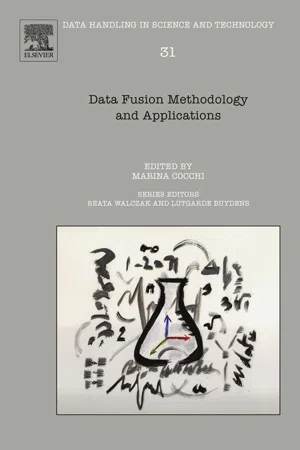
This is a test
- 396 pages
- English
- ePUB (mobile friendly)
- Available on iOS & Android
eBook - ePub
Data Fusion Methodology and Applications
Book details
Book preview
Table of contents
Citations
About This Book
Data Fusion Methodology and Applications explores the data-driven discovery paradigm in science and the need to handle large amounts of diverse data. Drivers of this change include the increased availability and accessibility of hyphenated analytical platforms, imaging techniques, the explosion of omics data, and the development of information technology. As data-driven research deals with an inductive attitude that aims to extract information and build models capable of inferring the underlying phenomena from the data itself, this book explores the challenges and methodologies used to integrate data from multiple sources, analytical platforms, different modalities, and varying timescales.
- Presents the first comprehensive textbook on data fusion, focusing on all aspects of data-driven discovery
- Includes comprehensible, theoretical chapters written for large and diverse audiences
- Provides a wealth of selected application to the topics included
Frequently asked questions
At the moment all of our mobile-responsive ePub books are available to download via the app. Most of our PDFs are also available to download and we're working on making the final remaining ones downloadable now. Learn more here.
Both plans give you full access to the library and all of Perlego’s features. The only differences are the price and subscription period: With the annual plan you’ll save around 30% compared to 12 months on the monthly plan.
We are an online textbook subscription service, where you can get access to an entire online library for less than the price of a single book per month. With over 1 million books across 1000+ topics, we’ve got you covered! Learn more here.
Look out for the read-aloud symbol on your next book to see if you can listen to it. The read-aloud tool reads text aloud for you, highlighting the text as it is being read. You can pause it, speed it up and slow it down. Learn more here.
Yes, you can access Data Fusion Methodology and Applications by Marina Cocchi in PDF and/or ePUB format, as well as other popular books in Physical Sciences & Analytic Chemistry. We have over one million books available in our catalogue for you to explore.
Information
Topic
Physical SciencesSubtopic
Analytic ChemistryChapter 4
Numerical Optimization-Based Algorithms for Data Fusion
N. Vervliet ∗ , 1 and L. De Lathauwer ∗ , § ∗KU Leuven, Department of Electrical Engineering ESAT/STADIUS, Kasteelpark Arenberg, Leuven, Belgium §Group Science, Engineering and Technology, KU Leuven - Kulak, Kortrijk, Belgium
1 Corresponding author
1 Corresponding author
Abstract
Combining various sources of information to discover hidden patterns is key in data analysis. These sources can often be represented as matrices and/or multiway arrays, or tensors, which can be factorized jointly, e.g., as sums of simple terms, to gain insight into the data. In this chapter, an overview of (the rationale behind) numerically well-founded optimization techniques based on a Gauss–Newton framework is given, which has superior convergence properties and allows all multilinear structure to be exploited. Prior knowledge in the form of parametric, box, or soft constraints as well as regularization can be incorporated easily. We show how matrices and/or tensors can be coupled through (partially) shared factors or through common underlying variables. The framework is further extended to more general divergences allowing more suitable statistical assumptions. Finally, as tensor problems become large scale quickly, owing to the curse of dimensionality, techniques used to alleviate or overcome this curse are discussed.
Keywords
Algorithms; Canonical polyadic decomposition; Constrained decomposition; Coupled decomposition; Data fusion; Gauss–Newton; Numerical optimization; Tensor decomposition
1. Introduction
Consider the two views of two point clouds in a 3D space in Fig. 4.1 . When looking at eit...
Table of contents
- Cover image
- Title page
- Copyright
- Table of Contents
- Contributors
- Preface
- Introduction:Ways and Means to Deal With Data From Multiple Sources
- A Framework for Low-Level Data Fusion
- General Framing of Low-, Mid-, and High-Level Data Fusion With Examples in the Life Sciences
- Numerical Optimization-Based Algorithms for Data Fusion
- Recent Advances in High-Level Fusion Methods to Classify Multiple Analytical Chemical Data
- The Sequential and Orthogonalized PLS Regression for Multiblock Regression
- ComDim Methods for the Analysis of Multiblock Data in a Data Fusion Perspective
- Data Fusion by Multivariate Curve Resolution
- Dealing With Data Heterogeneity in a Data Fusion Perspective
- Data Fusion Strategies in Food Analysis
- Image Fusion
- Data Fusion of Nonoptimized Models:Applications to Outlier Detection, Classification, and Image Library Searching
- Index